
Louse is the common name for members of the clade Phthiraptera, which contains nearly 5,000 species of wingless parasitic insect. Phthiraptera has variously been recognized as an order, infraorder, or a parvorder, as a result of developments in phylogenetic research.
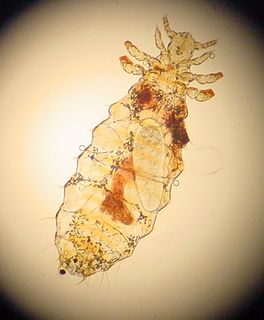
Sucking lice have around 500 species and represent the smaller of the two traditional superfamilies of lice. As opposed to the paraphyletic chewing lice, which are now divided among three suborders, the sucking lice are monophyletic.
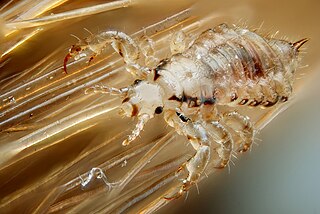
The head louse is an obligate ectoparasite of humans.

Tamias is a genus of chipmunks within the tribe Marmotini of the squirrel family. It includes a single living species, the eastern chipmunk The genus name Tamias means "treasurer", "steward", or "housekeeper", which is a reference to the animals' role in plant dispersal through their habit of collecting and storing food for winter use.

Psocoptera are a paraphyletic group of insects that are commonly known as booklice, barklice or barkflies. The name Psocoptera has been replaced with Psocodea in recent literature, with the inclusion of the former order Phthiraptera into Psocodea.
A bird louse is any chewing louse of order Phthiraptera which parasitizes warm-blooded animals, especially birds. Bird lice may feed on feathers, skin, or blood. They have no wings, and their biting mouth parts distinguish them from true lice, which suck blood.

Menoponidae is a monophyletic family of lice in the subfamily of chewing lice, Amblycera, often referred to as the chicken body louse family. They are ectoparasites of a wide range of birds including chickens, which makes them important to understand for veterinary science and for human health. However, Menoponidae are not exclusive to poultry and are common parasites for migratory birds, with more and more species being discovered every year.

Insect mandibles are a pair of appendages near the insect’s mouth, and the most anterior of the three pairs of oral appendages. Their function is typically to grasp, crush, or cut the insect’s food, or to defend against predators or rivals. Insect mandibles, which appear to be evolutionarily derived from legs, move in the horizontal plane unlike those of vertebrates, which appear to be derived from gill arches and move vertically.

Troctomorpha is one of the three major suborders of Psocodea (barklice, booklice, and parasitic lice), alongside Psocomorpha and Trogiomorpha. There are more than 30 families and 5,800 described species in Troctomorpha. The order includes parasitic lice, which are most closely related to the booklice family Liposcelididae.
Rheomys raptor, also known as the Goldman's water mouse or Goldman's Ichthyomyine, is a species of rodent in the family Cricetidae. This mouse is semiaquatic and its carnivorous diet includes invertebrates. The conservation status of the species is rated as "least concern" because of its sizable population and the presence of several protected areas within its range. However, deforestation and water pollution represent potential threats.

The Talas tuco-tuco is a species of tuco-tuco endemic to eastern Argentina.

Psocodea is a taxonomic group of insects comprising the bark lice, book lice and parasitic lice. It was formerly considered a superorder, but is now generally considered by entomologists as an order. Despite the greatly differing appearance of parasitic lice (Phthiraptera), they are believed to have evolved from within the former order Psocoptera, which contained the bark lice and book lice, now found to be paraphyletic. They are often regarded as the most primitive of the hemipteroids. Psocodea contains around 11,000 species, divided among four suborders and more than 70 families. They range in size from 1–10 millimetres (0.04–0.4 in) in length.

Paraneoptera or Acercaria is a superorder of insects which includes lice, thrips, and hemipterans, the true bugs. It also includes the extinct order Permopsocida, known from fossils dating from the Early Permian to the mid-Cretaceous.
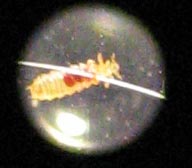
Polyplax spinulosa is a sucking louse (Anoplura) from the genus Polyplax. It occurs worldwide and commonly infects its type host, the brown rat, and related species like the black rat, Rattus pyctoris, Rattus nitidus, Rattus argentiventer, Rattus tanezumi, Rattus exulans, and Bandicota indica. It is also occasionally found in other rodents, such as the marsh rice rat in North America.
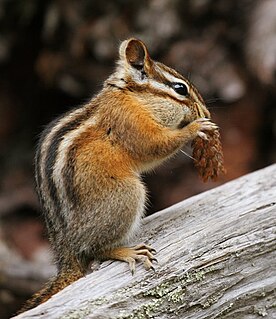
Neotamias is a genus of chipmunks within the tribe Marmotini of the squirrel family. It contains 23 species, which mostly occur in western North America. Along with Eutamias, this genus is often considered a subgenus of Tamias.
Gordon Floyd Ferris was an American entomologist who served as professor of biology at Stanford University from 1912 to 1958 and earned a reputation for his teaching. He founded and edited the journal Microentomology, preferring to work on insects that could only be examined on microscopic slides. He was a specialist on the systematics of the Coccoidea.
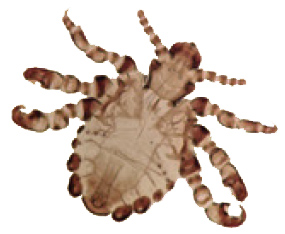
Pthirus gorillae or gorilla louse is a species of parasitic sucking louse that afflicts gorillas. It is found in the African continent, specifically in Rwanda and Democratic Republic of the Congo. Pthirus gorillae and Pthirus pubis are the only known species that belong to the genus Pthirus, often incorrectly spelled as Phthirus. It is suggested that it is transmitted among its hosts by social grooming, shared bedding and sexual contact.
Lemurpediculus verruculosus is an ectoparasite that is found on Microcebus rufus, a mouse lemur of southeastern Madagascar. It is a type of sucking louse that is found on the external ears of the mouse lemur due to the rich peripheral blood supply and sparse fur. The mouse lemur M. rufus is the only known host to this particular sucking louse, and infestations range from light to fairly heavy on the ears. The exact effect these lice have on the host is largely unknown.

Echinophthiriidae is a family of lice in the suborder Anoplura, the sucking lice. This family of lice are parasites of seals and the river otter, and are the only insects that infest aquatic hosts.
Lemurpediculus robbinsi is an ectoparasite of Crossley's dwarf lemur, Cheirogaleus crossleyi A. Grandidier, in Madagascar. Both sexes of the louse species are distinct from the two previously known species of Lemurpediculus, L. verruculosus (Ward) and L. petterorum Paulian.















